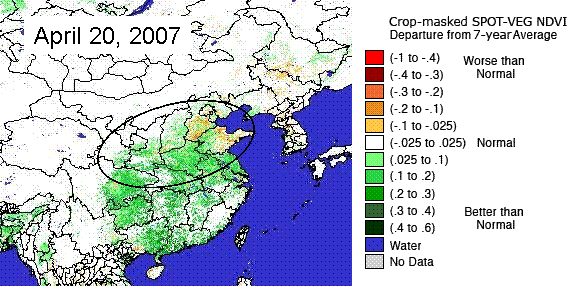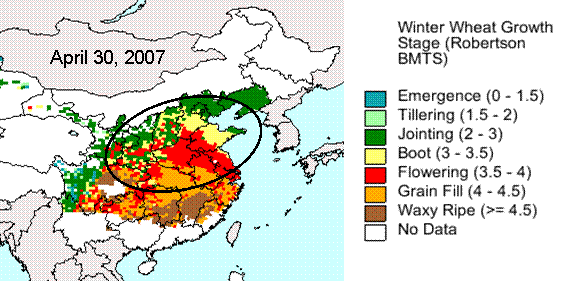China - Winter Wheat and Rapeseed Update
Summary
Unusually mild winter temperatures caused China's 2007/08 winter wheat and rapeseed crops to emerge from dormancy well ahead of schedule and grow abnormally fast, weakening their resistance to extreme weather. The mild winter also created ideal conditions for insects and plant diseases to thrive, but local authorities have taken appropriate control measures. Rainfall and temperatures have been highly variable in March and April. Two episodes of cold weather caused minor freeze damage but had little impact on overall crop yields, while above normal temperatures in mid-March and mid-April stressed vegetative/reproductive wheat and rapeseed crops in some areas. Total rainfall since November is above normal, and soil moisture levels range from abundant (south) to short (north), typical for this time of year. The wheat crop was in the jointing to flowering stage as of April 20. Based on NDVI data and satellite imagery, winter crops appear to be growing well. Yield prospects are fair to good in the Yellow River basin and very good in the southern plains and Yangtze River basin.
Winter Wheat Vegetative Growth

The most important wheat-growing provinces are Henan, Shandong, Hebei, Anhui, and Jiangsu, located on the North China Plain (NCP). These five provinces account for more than 75 percent of total winter wheat production. Rapeseed is grown primarily in the Yangtze River valley and Sichuan Basin. Hubei, Anhui, Jiangsu, Hunan, and Sichuan are the five most important rapeseed provinces.
Dry Planting Weather
The 2007/08 winter wheat and rapeseed crops were planted in September/October 2006. Clear and warm autumn weather allowed farmers to quickly plant their winter crops. The western and southern plains had abundant rainfall, but supplemental irrigation was needed in Hebei, Shandong, Beijing and Tianjin to compensate for the near total absence of surface soil moisture. Planted area in Shandong was down an estimated five percent from last year due to dry soils and insufficient water for irrigation. However, widespread heavy rain at the end of November eased drought conditions in the north and the crop entered dormancy on schedule in early to mid-December.
According to China's Ministry of Agriculture, the winter wheat crop as of December was rated about the same as last year in Hebei, Hubei, Xinjiang; better than last year in Shanxi, Shandong, Henan and Gansu; and worse than last year in Anhui, Jiangsu, Shaanxi, and Sichuan.
Winter Weather Second Warmest in History
A report by the China Meteorological Bureau (CMB) stated that temperatures from December through February averaged 2.4 degrees C, making the winter of 2006/07 the second-warmest on record. Average temperatures were almost 2.0 degrees C. above normal, which caused the crop to emerge from dormancy up to three weeks ahead of schedule. With temperatures averaging 4 - 6 degrees C. above normal, it was the warmest February in more than 50 years. By the end of the month, the warm temperatures and seasonal dryness had resulted in light to moderate drought in many areas of the country, including Shandong, the Sichuan basin, Guangxi, Hainan, and Liaoning. However, timely precipitation and mild temperatures were ideal for winter wheat green-up in the northwest (Gansu/Ningxia) and rapid vegetative growth in the Yangtze River basin and southern plains, which could be clearly seen on satellite imagery.
The CMB reported that the wheat crop had survived the winter with no apparent freeze damage, but it expressed concern that yields would suffer due to water stress and above-normal number of pests (such as aphids and red spiders) which had survived the mild winter.
Changeable Weather in March
The winter's unseasonably warm weather pattern was broken in early March when a strong storm system brought heavy precipitation (rain/snow mix) and much cooler temperatures to most of eastern China from March 5-8. Up to 2 inches of precipitation was reported on the North China Plain from the storm, instantly raising surface soil moisture levels from near zero to near saturation. The rain helped to ease the drought in Shandong, Ningxia and Shaanxi but did not erase it completely. Although most of the precipitation was in the form of rain, a blanket of snow covered crops in central and northern Hebei, northern Shandong, and the Northwest, offering some protection from temperatures that dropped as low as -10 degrees C. According to local reports, only a small area of wheat in western Shandong and north-central Hebei experienced freeze damage.

The rapeseed crop was generally unaffected by the cold weather in early March. Although temperatures dropped below freezing in the Yangtze River valley and southern parts of the North China Plain on March 6-7, the coldest temperatures (-5 degrees C) were reported outside the main rapeseed production areas. On the other hand, temperatures were unfavorably warm at the end of March (up to 33 degrees C. in the Yangtze valley and 31 degrees C. in Henan), causing soil moisture levels to drop and stressing rapeseed in the flowering stage.
Another wintry blast in early April dropped temperatures below freezing on parts of the North China Plain, but there were no reports of significant freeze damage. The cold front was preceded by widely scattered showers and a major dust storm on the night of March 31-April 1. Although other dust storms had been reported in Northwest China in 2007, this was the first to affect the Beijing metropolitan area. China normally sees 10 to 15 major sandstorms every spring.
April Weather is Close to Normal, Crop Calendar is Ahead of Schedule

Average temperatures in April have been near to above normal, with maximum temperatures generally in the 15 to 25 C. range. However, the temperature extremes (-1 to 32 degrees C.) were quite large. Scattered showers at mid-month benefited crops in the southern plains and Sichuan basin and eased dry conditions in Shandong, but most of the Yellow River basin has received very little precipitation since early March, causing soil moisture levels to drop sharply. Local authorities reported that insects and diseases such as wheat stripe rust and powdery mildew were significantly more common than last year in Hubei, Henan, Hebei, and Shandong. In response, they have encouraged farmers to use more pesticides and increase their management efforts in order to keep these problems under control.
As of April 30, the winter wheat crop was in the boot/flowering stage on the North China Plain and in the flowering/grain fill stage in the Yangtze River basin. Most of the rapeseed crop was in the filling/maturing stage. The crops remain ahead of schedule by one to two weeks, and harvesting is expected to be well underway by the end of May. Based on satellite imagery and NDVI analysis, China's winter crops appear to be in very good condition in the Yangtze River valley and southern plains (Henan, Anhui, and Jiangsu) and fair to good condition in the Yellow River basin. As the wheat crop moves through the heading/filling stage over the next two weeks, it will be especially vulnerable to damage from extreme heat and moisture stress. Heavy rain during harvest could also have a major impact on yields, particularly for the rapeseed crop.
The first USDA estimate for the 2007/08 wheat crop will be released on May 11, 2007 and the first estimate for the 2007/08 rapeseed crop will be released on June 11, 2007
Link: Crop Explorer
|

